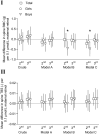Maternal vitamin A and D status in second and third trimester of pregnancy and bone mineral content in offspring at nine years of age
- PMID: 39006361
- PMCID: PMC11239386
- DOI: 10.3389/fendo.2024.1417656
Maternal vitamin A and D status in second and third trimester of pregnancy and bone mineral content in offspring at nine years of age
Abstract
Introduction: Maternal nutritional and vitamin status during pregnancy may have long-term effects on offspring health and disease. The aim of this study was to examine the associations between maternal vitamin A and D status in pregnancy and offspring bone mineral content (BMC) at nine years of age.
Methods: This is a post-hoc study of a randomized control trial including 855 pregnant women from two Norwegian cities; Trondheim and Stavanger. The women were randomized into an exercise intervention or standard antenatal care. Mother and child pairs for the present study were recruited from those still living in Trondheim after 8-10 years. Serum vitamin A (retinol) and vitamin D (25(OH)D) were measured in the 2nd and 3rd trimesters of pregnancy, and active vitamin D (1,25(OH)2D) in serum was measured in a subgroup. Spine BMC and trabecular bone score were measured in the children at nine years of age. Associations were analyzed with linear regression models.
Results: A total of 119 mother and child pairs were included in the analyses. Vitamin A insufficiency (retinol< 1.05 µmol/L) and vitamin D deficiency (25(OH)D< 50 mmol/L) increased from ~7% to ~43% and from ~28% to ~33%, respectively, from the 2nd to the 3rd trimester. An increase in serum 1,25(OH)2D from the 2nd to the 3rd trimester was observed in the subgroup. There was a negative association between serum retinol in the 2nd trimester and spine BMC in the boys, but not in the girls, when adjusted for maternal and child confounders. No other associations between maternal serum vitamin A or D and BMC in the children were found.
Conclusion: We observed a high prevalence of vitamin A insufficiency and vitamin D deficiency during pregnancy. A negative association between mid-pregnancy vitamin A status and spine BMC was observed in boys, but not girls, while no associations were found between maternal vitamin D status and child BMC. The implications of optimal vitamin A and D status in pregnancy for offspring bone health, remains a subject for further investigations.
Keywords: 1,25(OH)2D; 25(OH)D; offspring bone mass; pregnancy; retinol; vitamin A; vitamin D.
Copyright © 2024 Stunes, Mosti, Gustafsson, Børsting, Thorsby, Stafne and Syversen.
Conflict of interest statement
The authors declare that the research was conducted in the absence of any commercial or financial relationships that could be construed as a potential conflict of interest.
Figures



References
Publication types
MeSH terms
Substances
LinkOut - more resources
Full Text Sources
Medical
Miscellaneous

